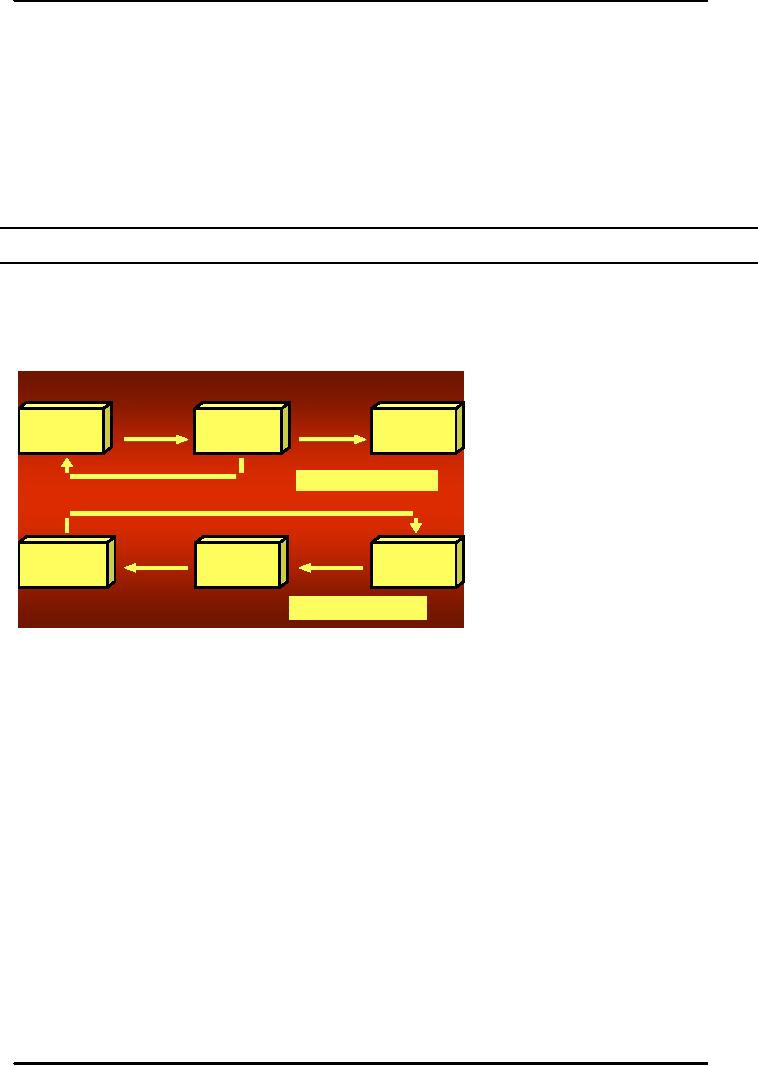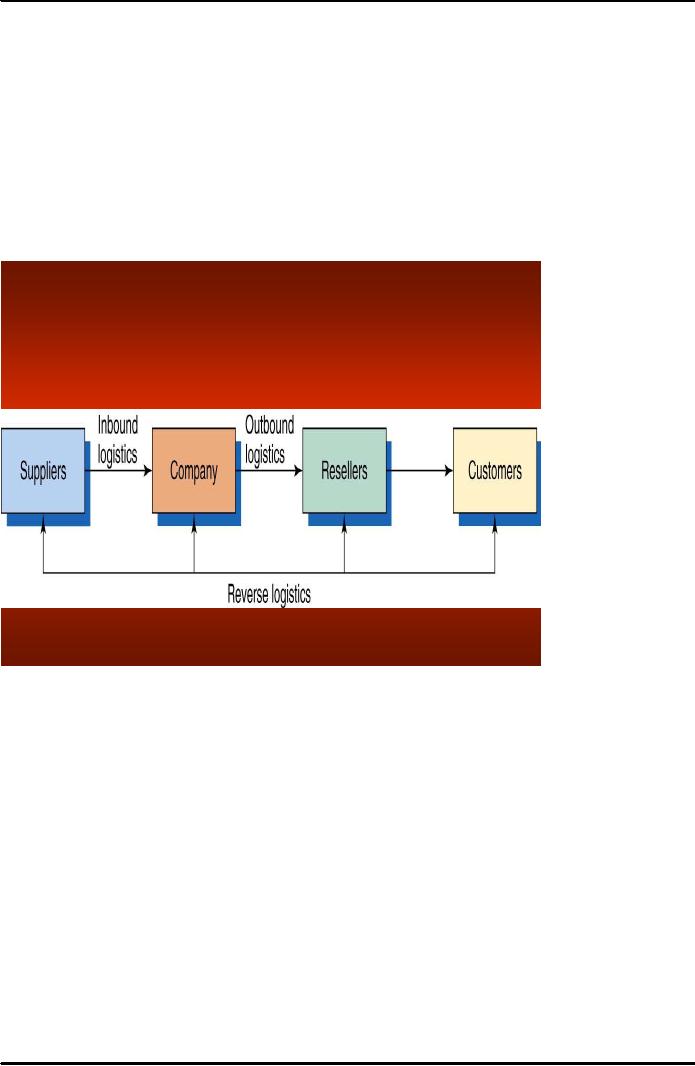 |

Principles
of Marketing MGT301
VU
Lesson
29
Lesson
overview and learning objectives:
In today's global
marketplace, selling a product is
sometimes easier than getting it to
customers.
Therefore,
physical distribution and logistics
management are receiving increased
attention from
strategic
planners. The task of physical
distribution systems is to minimize
the total cost of
providing
a desired level of customer
services while bringing those
services to the customer
with
the
maximum amount of speed.
Major logistics functions of
order processing, warehousing,
inventory
management, and transportation
are discussed and explored
in today's Lesson.
LOGISTIC
MANAGEMENT
A.
Push Versus Pull
Strategy:
A
promotion strategy that
calls for using the sales
force and trade promotion to
push the product
through
the channel is called push
strategy. The producer promotes
the product to wholesalers,
the
wholesalers
promote to retailers and the
retailers promote to consumers. While
the pull strategy is
the
promotional strategy
that
calls
for spending a lot on
advertising
and
consumer
Marketing
Demand
activities
promotion
to
build
up
Interme-
Producer
End
users
diaries
consumer
demand; if successful,
Demand
consumer
will ask their
retailers
Push
Strategy
for
the product, the retailer
will
ask
the wholesalers
and
Marketing
activities
wholesalers
will ask
the
producers.
So these are two
Demand
Demand
Interme-
Producer
End
users
strategies
through
which
diaries
availability
of products can be
Pull
St rategy
created
in the market for
final
consumers.
B.
Physical
Distribution and Logistics
Management
Companies
must decide on the best
way to store, handle, and
move their products and
services so
that
they are available to customers in
the right assortments, at
the right time, and in
the right
place.
Logistics effectiveness has a
major impact on both customer satisfaction
and company costs.
Here
we consider the nature
and importance of marketing logistics,
goals of the logistics system, major
logistics
functions,
and
the need for integrated
logistics management.
a.
Nature and Importance of
Physical Distribution and
Marketing Logistics
To
some managers, physical distribution
means only trucks and
warehouses. But modern
logistics
is
much more than this.
Physical distribution--or marketing
logistics--involves planning,
implementing,
and controlling the physical
flow of materials, final
goods, and related
information
from
points of origin to points of
consumption to meet customer requirements at a
profit. In
short,
it involves getting the right
product to the right customer in
the right place at the
right time.
Traditional
physical distribution typically started
with products at the plant
and then tried to
find
low-cost
solutions to get them to
customers. However, today's
marketers prefer market
logistics
thinking,
which starts with the
marketplace and works
backward to the factory.
Logistics addresses
not
only the problem of outbound
distribution (moving products
from the factory to
customers)
but
also the problem of inbound
distribution (moving products
and materials from suppliers
to the
factory).
141

Principles
of Marketing MGT301
VU
It
involves the management of
entire supply
chains, value-added
flows from suppliers to
final users,
as
shown in Figure . Thus, the
logistics manager's task is to coordinate
activities of suppliers,
purchasing
agents, marketers, channel
members, and customers. These activities
include
forecasting,
information systems, purchasing,
production planning, order
processing, inventory,
warehousing,
and transportation
planning.
Companies
today are placing greater emphasis on
logistics for several
reasons. First,
customer
service
and satisfaction have become
the cornerstones of marketing strategy, and
distribution is an
important
customer service element. More
and more, companies are
finding that they can
attract
and
keep customers by giving better
service or lower prices
through better physical
distribution.
Second,
logistics is a major cost element
for most companies.
According to one study, in a
recent
year
American companies "spent $670
billion--a gaping 10.5 percent of
gross domestic
product--
to
wrap, bundle, load, unload,
sort, reload, and transport
goods." About 15 percent of an
average
product's
price is
accounted
for by
shipping
and
transport
alone.
Su
ppl y Chai n M anageme nt
Poor
physical
distribution
decisions
result in
high
costs.
Improvements
in
physical
distribution
efficiency
can yield
tremendous
cost
savings
for both
the
company and
its
customers.
Third,
the
explosion
in
product
variety has
created
a need for
improved
logistics
management.
Finally, improvements in information
technology have created
opportunities for
major
gains in distribution efficiency.
The increased use of computers,
point-of-sale scanners,
uniform
product codes, satellite
tracking, electronic data interchange
(EDI), and electronic
funds
transfer
(EFT) has allowed companies to
create advanced systems for
order processing,
inventory
control
and handling, and
transportation routing and
scheduling.
b.
Goals of the Logistics System
Some
companies state their
logistics objective as providing maximum
customer service at the
least
cost.
Unfortunately, no logistics system
can both
maximize customer
service and
minimize
distribution
costs. Maximum customer
service implies rapid delivery, large
inventories, flexible
assortments,
liberal returns policies, and
other services--all of which
raise distribution costs.
In
contrast,
minimum distribution costs
imply slower delivery, smaller
inventories, and larger
shipping
lots--which
represent a lower level of
overall customer
service.
The
goal of the marketing
logistics system should be to
provide a targeted level of
customer
service
at the least cost. A company
must first research the
importance of various distribution
services
to its customers and then set
desired service levels for
each segment. The
company
normally
will want to offer at least
the same level of service as
its competitors do. But the
objective
is
to maximize profits,
not
sales. Therefore, the
company must weigh the benefits of
providing
higher
levels of service against
the costs. Some companies
offer less service than
their competitors
142

Principles
of Marketing MGT301
VU
and
charge a lower price. Other
companies offer more service
and charge higher prices to
cover
higher
costs.
c.
Major Logistics Functions
Given
a set of logistics objectives, the
company is ready to design a
logistics system that
will
minimize
the cost of attaining these objectives.
The major logistics
functions include order
processing,
warehousing,
inventory management, and
transportation.
i.
Order
Processing
Orders
can be submitted in many
ways--by mail or telephone, through
salespeople, or via
computer
and EDI. In some cases,
the suppliers might actually
generate orders for their
customers:
Once
received, orders must be
processed quickly and accurately.
Both the company and
its
customers
benefit when order
processing is carried out
efficiently. Most companies
now use
computerized
order-processing systems that
speed up the
ordershippingbilling cycle.
For
example,
General Electric operates a
computer-based system that, on
receipt of a customer's order,
checks
the customer's credit standing as well as
whether and where the items
are in stock. The
computer
then issues an order to ship,
bills the customer, updates
the inventory records, sends
a
production
order for new stock, and
relays the message back to
the salesperson that the
customer's
order
is on its way--all in less than 15
seconds.
ii.
Warehousing
Every
company must store its goods
while they wait to be sold. A
storage function is
needed
because
production and consumption
cycles rarely match. A company
must decide on how
many
and
what
types of
warehouses it needs and
where
they
will be located. The company
might use either
storage
warehouses or
distribution
centers. Storage
warehouses store goods for
moderate to long
periods.
Distribution
centers are designed to move
goods rather than just
store them. They are
large and
highly
automated warehouses designed to receive
goods from various plants
and suppliers, take
orders,
fill them efficiently, and
deliver goods to customers as quickly as
possible.
Warehousing
facilities and equipment technology
have improved greatly in recent years.
Older,
multistoried
warehouses with outdated materials-handling methods
are facing competition
from
newer,
single-storied automated
warehouses with
advanced materials-handling systems under
the
control
of a central computer. In these
warehouses, only a few
employees are
necessary.
Computers
read orders and direct lift
trucks, electric hoists, or robots to
gather goods, move
them
to
loading docks, and issue invoices.
These warehouses have
reduced worker injuries,
labor costs,
theft,
and breakage and have
improved inventory
control.
iii.
Inventory
Inventory
levels also affect customer
satisfaction. The major problem is to
maintain the delicate
balance
between carrying too much
inventory and carrying too
little. Carrying too much
inventory
results
in higher-than-necessary inventory-carrying costs
and stock obsolescence. Carrying
too little
may
result in stock outs, costly
emergency shipments or production, and
customer dissatisfaction.
In
making inventory decisions, management
must balance the costs of
carrying larger inventories
against
resulting sales and
profits.
During
the past decade, many
companies have greatly reduced
their inventories and
related costs
through
just-in-time
logistics
systems. Through such systems, producers
and retailers carry
only
small
inventories of parts or merchandise,
often only enough for a
few days of operations.
New
stock
arrives exactly when needed,
rather than being stored in
inventory until being used.
Just-in-
time
systems require accurate forecasting along
with fast, frequent, and
flexible delivery so
that
new
supplies will be available
when needed. However, these
systems result in substantial savings
in
inventory-carrying
and handling costs.
iv.
Transportation
Marketers
need to take an interest in their
company's transportation
decisions.
The choice of
transportation
carriers affects the pricing of
products, delivery performance, and
condition of the
goods
when they arrive--all of
which will affect customer satisfaction.
In shipping goods to its
143

Principles
of Marketing MGT301
VU
warehouses,
dealers, and customers, the
company can choose among
five transportation
modes:
rail,
truck, water, pipeline, and
air.
Railroads
are
the nation's largest carrier,
accounting for 26 percent of total
cargo ton-miles
moved.
They
are one of the most
cost-effective modes for shipping
large amounts of bulk
products--coal,
sand,
minerals, farm and forest
products--over long distances. In recent
years, railroads have
increased
their customer services by designing
new equipment to handle special
categories of
goods,
providing flatcars for carrying
truck trailers by rail (piggyback),
and providing
in-transit
services
such as the diversion of shipped
goods to other destinations en route
and the processing
of
goods en route. Thus, after
decades of losing out to truckers,
railroads appear ready for
a
comeback.
Trucks
have
increased their share of
transportation steadily and
now account for 24 percent of
total
cargo
ton-miles (over 52 percent of actual
tonnage). They account for
the largest portion
of
transportation
within
cities
as opposed to between
cities.
Trucks are highly flexible
in their routing
and
time schedules, and they
can usually offer faster
service than railroads. They
are efficient for
short
hauls of high-value merchandise. Trucking
firms have added many
services in recent years.
Pipelines
are a
specialized means of shipping petroleum,
natural gas, and chemicals
from sources to
markets.
Most pipelines are used by
their owners to ship their own
products.
Although
air
carriers
transport less than 1 percent of
the nation's goods, they
are becoming more
important
as a transportation mode. Air
freight rates are much
higher than rail or truck
rates, but
air
freight is ideal when speed
is needed or distant markets
have to be reached. Among
the most
frequently
air-freighted products are
perishables (fresh fish, cut
flowers) and high-value,
low-bulk
items
(technical instruments, jewelry).
Companies find that air
freight also reduces
inventory levels,
packaging
costs, and the number of
warehouses needed.
Shippers
increasingly are using intermodal
transportation--combining two or more
modes of
transportation.
Piggyback
describes
the use of rail and
trucks; fishyback,
water
and trucks; trainship,
water
and rail; and airtruck,
air
and trucks. Combining modes
provides advantages that no
single
mode
can deliver. Each combination
offers advantages to the shipper.
For example, not only
is
piggyback
cheaper than trucking alone
but it also provides flexibility
and convenience.
In
choosing a transportation mode for a
product, shippers must
balance many considerations:
speed,
dependability, availability, cost, and
others. Thus, if a shipper needs speed,
air and truck
are
the
prime choices. If the goal
is low cost, then water or pipeline
might be best. Shipping costs
are
often
a significant portion of the marketing
costs of a product. It is often
difficult for businesses
to
pass
on these higher costs to customers
when there are active
competitors. One option is to
reduce
dependence
on the unreliable transportation.
However, that may not be
possible for some
businesses.
As the case you just
read suggests, a company's physical
distribution and
transportation
flexibility
is an important part of its marketing
decisions, a factor that
could make or break
its
ability
to serve its customers.
d.
Integrated Logistics
Management
Today,
more and more companies
are adopting the concept of integrated
logistics management.
This
concept recognizes that providing
better customer service and
trimming distribution
costs
requires
teamwork,
both
inside the company and
among all the marketing
channel organizations.
Inside,
the company's various functional departments
must work closely together to
maximize the
company's
own logistics performance. Outside,
the company must integrate
its logistics system
with
those of its suppliers and customers to maximize
the performance of the entire
distribution
system.
Cross-Functional
Teamwork Inside the Company
In
most companies, responsibility
for various logistics activities is
assigned to many
different
functional
units--marketing, sales, finance,
manufacturing, purchasing. Too often,
each function
tries
to optimize its own logistics performance
without regard for the
activities of the other
functions.
However, transportation, inventory,
warehousing, and order-processing
activities
interact,
often in an inverse way. For
example, lower inventory
levels reduce
inventory-carrying
144

Principles
of Marketing MGT301
VU
costs.
But they may also
reduce customer service and
increase costs from stock
outs, back orders,
special
production runs, and costly
fast-freight shipments. Because
distribution activities involve
strong
trade-offs, decisions by different
functions must be coordinated to achieve
superior overall
logistics
performance.
The
goal of integrated logistics management
is to harmonize all of the company's
distribution
decisions.
Close working relationships among
functions can be achieved in
several ways. Some
companies
have created permanent
logistics committees made up of managers
responsible for
different
physical distribution activities. Companies
can also create management
positions that link
the
logistics activities of functional areas.
Many companies have a vice
president of logistics with
cross-functional
authority. The important
thing is that the company
coordinate its logistics and
marketing
activities to create high market satisfaction at a
reasonable cost.
e.
Building Channel Partnerships
The
members of a distribution channel
are linked closely in delivering customer
satisfaction and
value.
One company's distribution system is
another company's supply system.
The success of each
channel
member depends on the performance of
the entire supply chain.
Companies must do
more
than improve their own
logistics. They must also
work with other channel
members to
improve
whole-channel distribution. Today, smart
companies are coordinating
their logistics
strategies
and building strong partnerships
with suppliers and customers to
improve customer
service
and reduce channel
costs.
These
channel partnerships can take
many forms. Many companies
have created cross-functional,
cross-company
teams.
Other
companies partner through
shared
projects. For
example, many larger
retailers are working
closely
with suppliers on in-store
programs. Channel partnerships may
also take the form
of
information
sharing and
continuous
inventory replenishment systems.
Companies manage their
supply
chains
through information. Suppliers
link up with customers to share
information and coordinate
their
logistics decisions. Here
are just two
examples:
Today,
as a result of such partnerships, many
companies have switched from
anticipatory-based
distribution
systems to
response-based
distribution systems. In
anticipatory distribution, the
company
produces
the amount of goods called
for by a sales forecast. It
builds and holds stock at
various
supply
points, such as the plant,
distribution centers, and retail
outlets. A response-based
distribution
system, in contrast, is customer
triggered. The
producer continuously builds
and replaces
stock
as orders arrive. It produces what is
currently selling.
f.
Third-Party Logistics
Companies
may use third-party
logistics providers for
several reasons. First,
because getting the
product
to market is their main focus,
these providers can often do
it more efficiently and at
lower
cost
than clients whose strengths lie
elsewhere. According to one study,
outsourcing warehousing
alone
typically results in 10 percent to 15 percent cost
savings. Another expert
estimates that
companies
can save 15 percent to 25 percent in
their total logistics costs
by outsourcing. Second,
outsourcing
logistics frees a company to
focus more intensely on its
core business.
Finally,
integrated
logistics companies understand increasingly
complex logistics environments.
This can be
especially
helpful to companies attempting to
expand their global market
coverage.
KEY
TERMS (Lesson # 28-29)
distribution
channel
A
set of interdependent organizations
involved in the process of making a
product or service
available
for use or consumption by
the consumer or business user.
Channel
level
A
layer of intermediaries that
performs some work in
bringing the product and its
ownership
closer
to the final buyer.
145

Principles
of Marketing MGT301
VU
Direct
marketing channel
A
marketing channel that has no
intermediary levels.
Indirect
marketing channel
Channel
containing one or more intermediary
levels.
Channel
conflict
Disagreement
among marketing channel members on
goals and roles--who should
do what and
for
what rewards.
Conventional
distribution channel
A
channel consisting of one or more independent
producers, wholesalers, and retailers,
each a
separate
business seeking to maximize its
own profits even at the
expense of profits for the
system
as
a whole.
Vertical
Marketing System
(VMS)
A
distribution channel structure in
which producers, wholesales, and
retailers act as a
unified
system.
One channel member owns the
others, has contracts with them, or
has so much power
that
they all cooperate
Corporate
VMS
A
vertical marketing system that
combines successive stages of
production and distribution
under
single
ownership--channel leadership is
established through common
ownership.
Contractual
VMS
A
vertical marketing system in which
independent firms at different levels of
production and
distribution
join together through contracts to
obtain more economies or
sales impact than
they
could
achieve alone.
Franchise
organization
A
contractual vertical marketing system in
which a channel member,
called a franchiser,
links
several
stages in the production-distribution
process.
Administered
VMS
A
vertical marketing system that
coordinates successive stages of
production and distribution,
not
through
common ownership or contractual
ties but through the
size and power of one of
the
parties.
Horizontal
marketing system
A
channel arrangement in which two or
more companies at one level
join together to follow a
new
marketing
opportunity.
Hybrid
marketing channel
Multi
channel distribution system in
which a single firm sets up
two or more marketing channels to
reach
one or more customer
segments.
Intensive
distribution
Stocking
the product in as many
outlets as possible.
146

Principles
of Marketing MGT301
VU
Exclusive
distribution
Giving
a limited number of dealers
the exclusive right to distribute
the company's products in
their
territories.
Selective
distribution
The
use of more than one, but
fewer than all, of the
intermediaries who are
willing to carry the
company's
products.
Physical
distribution (or marketing
logistics)
The
tasks involved in planning,
implementing, and controlling
the physical flow of materials,
final
goods,
and related information from
points of origin to points of
consumption to meet customer
requirements
at a profit.
Distribution
center
A
large, highly automated warehouse
designed to receive goods
from various plants and
suppliers,
take
orders, fill them
efficiently, and deliver
goods to customers as quickly as
possible.
Integrated
logistics management
The
logistics concept that emphasizes
teamwork, both inside the
company and among all
the
marketing
channel organizations, to maximize the
performance of the entire
distribution system.
Third-party
logistics provider
An
independent logistics provider that
performs any or all of the
functions required to get
their
clients'
product to market.
147
Table of Contents:
- PRINCIPLES OF MARKETING:Introduction of Marketing, How is Marketing Done?
- ROAD MAP:UNDERSTANDING MARKETING AND MARKETING PROCESS
- MARKETING FUNCTIONS:CUSTOMER RELATIONSHIP MANAGEMENT
- MARKETING IN HISTORICAL PERSPECTIVE AND EVOLUTION OF MARKETING:End of the Mass Market
- MARKETING CHALLENGES IN THE 21st CENTURY:Connections with Customers
- STRATEGIC PLANNING AND MARKETING PROCESS:Setting Company Objectives and Goals
- PORTFOLIO ANALYSIS:MARKETING PROCESS,Marketing Strategy Planning Process
- MARKETING PROCESS:Analyzing marketing opportunities, Contents of Marketing Plan
- MARKETING ENVIRONMENT:The Company’s Microenvironment, Customers
- MARKETING MACRO ENVIRONMENT:Demographic Environment, Cultural Environment
- ANALYZING MARKETING OPPORTUNITIES AND DEVELOPING STRATEGIES:MIS, Marketing Research
- THE MARKETING RESEARCH PROCESS:Developing the Research Plan, Research Approaches
- THE MARKETING RESEARCH PROCESS (Continued):CONSUMER MARKET
- CONSUMER BUYING BEHAVIOR:Model of consumer behavior, Cultural Factors
- CONSUMER BUYING BEHAVIOR (CONTINUED):Personal Factors, Psychological Factors
- BUSINESS MARKETS AND BUYING BEHAVIOR:Market structure and demand
- MARKET SEGMENTATION:Steps in Target Marketing, Mass Marketing
- MARKET SEGMENTATION (CONTINUED):Market Targeting, How Many Differences to Promote
- Product:Marketing Mix, Levels of Product and Services, Consumer Products
- PRODUCT:Individual product decisions, Product Attributes, Branding
- PRODUCT:NEW PRODUCT DEVELOPMENT PROCESS, Idea generation, Test Marketing
- NEW PRODUCT DEVELOPMENT:PRODUCT LIFE- CYCLE STAGES AND STRATEGIES
- KEY TERMS:New-product development, Idea generation, Product development
- Price the 2nd P of Marketing Mix:Marketing Objectives, Costs, The Market and Demand
- PRICE THE 2ND P OF MARKETING MIX:General Pricing Approaches, Fixed Cost
- PRICE THE 2ND P OF MARKETING MIX:Discount and Allowance Pricing, Segmented Pricing
- PRICE THE 2ND P OF MARKETING MIX:Price Changes, Initiating Price Increases
- PLACE- THE 3RD P OF MARKETING MIX:Marketing Channel, Channel Behavior
- LOGISTIC MANAGEMENT:Push Versus Pull Strategy, Goals of the Logistics System
- RETAILING AND WHOLESALING:Customer Service, Product Line, Discount Stores
- KEY TERMS:Distribution channel, Franchise organization, Distribution center
- PROMOTION THE 4TH P OF MARKETING MIX:Integrated Marketing Communications
- ADVERTISING:The Five M’s of Advertising, Advertising decisions
- ADVERTISING:SALES PROMOTION, Evaluating Advertising, Sales Promotion
- PERSONAL SELLING:The Role of the Sales Force, Builds Relationships
- SALES FORCE MANAGEMENT:Managing the Sales Force, Compensating Salespeople
- SALES FORCE MANAGEMENT:DIRECT MARKETING, Forms of Direct Marketing
- DIRECT MARKETING:PUBLIC RELATIONS, Major Public Relations Decisions
- KEY TERMS:Public relations, Advertising, Catalog Marketing
- CREATING COMPETITIVE ADVANTAGE:Competitor Analysis, Competitive Strategies
- GLOBAL MARKETING:International Trade System, Economic Environment
- E-MARKETING:Internet Marketing, Electronic Commerce, Basic-Forms
- MARKETING AND SOCIETY:Social Criticisms of Marketing, Marketing Ethics
- MARKETING:BCG MATRIX, CONSUMER BEHAVIOR, PRODUCT AND SERVICES
- A NEW PRODUCT DEVELOPMENT:PRICING STRATEGIES, GLOBAL MARKET PLACE